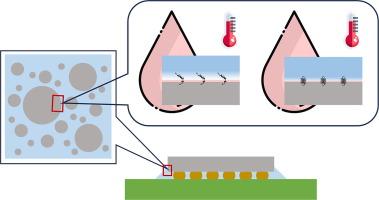Systematic study of the effect of silane coupling agent on the hydrothermal aging resistance of the underfill epoxy resin and silica interface via molecular dynamics simulation
IF 6.9
2区 材料科学
Q2 CHEMISTRY, PHYSICAL
引用次数: 0
Abstract
Molecular dynamics simulations are used to elucidate the mechanism by which silane coupling agents (SCAs) affect the hydrothermal aging resistance of the epoxy resin (EP)/silica interface, which is the main type of interface existed in/around the underfill adhesive (UF). A hybrid model is constructed based on the amorphous silica surface, and two types of reactive SCA (i.e. the epoxy-functionalized SCA 1 and the amine-functionalized SCA 2) are chemically introduced. In this study, microscopic interfacial structures and properties for unaged and aged conditions are evaluated and compared. We find that both SCAs can enhance the interfacial energies between EP and the silica surface, which consequently increases the stability at the interfaces under hydrothermal aging conditions. The covalent contribution in SCA 2 is significantly higher than in SCA 1, which is a principal factor contributing to the stabilization of the interface. Therefore, both SCA can be taken as effective “springs” that connect the EP and silica surface. Moreover, SCA 1 can be taken as longer but flexural “springs” with lower spring constant, which also reduces the interfacial density of EP and allow for greater water ingress; while SCA 2 can be taken as shorter but straight “springs” with higher spring constant, which significantly reinforce the interface. These findings provide us microscopic insights into the impact of SCA on the EP/silica surface, which could be helpful in the selection of more effective SCAs that improve the hydrothermal aging resistance of UF.


通过分子动力学模拟,系统研究了硅烷偶联剂对环氧树脂和二氧化硅界面抗水热老化性能的影响
采用分子动力学模拟方法研究了硅烷偶联剂(SCAs)对环氧树脂(EP) /二氧化硅界面抗水热老化性能的影响机理。环氧树脂(EP) /二氧化硅界面是底填料胶粘剂(UF)内部和周围存在的主要界面类型。在无定形二氧化硅表面建立了杂化模型,并介绍了两种活性SCA(即环氧功能化SCA 1和胺功能化SCA 2)的化学性质。在本研究中,对未老化和老化条件下的微观界面结构和性能进行了评价和比较。我们发现这两种SCAs都可以提高EP和二氧化硅表面之间的界面能,从而提高界面在水热老化条件下的稳定性。在SCA 2中共价的贡献明显高于SCA 1,这是促进界面稳定的主要因素。因此,两种SCA都可以作为连接EP和二氧化硅表面的有效“弹簧”。此外,SCA 1可以被视为具有较低弹簧常数的较长但弯曲的“弹簧”,这也降低了EP的界面密度并允许更大的水进入;而sca2可以看作是更短但更直的“弹簧”,具有更高的弹簧常数,可以显著增强界面。这些发现为我们提供了SCA对EP/二氧化硅表面影响的微观视角,这可能有助于选择更有效的SCA来提高UF的水热老化性能。
本文章由计算机程序翻译,如有差异,请以英文原文为准。
求助全文
约1分钟内获得全文
求助全文
来源期刊

Applied Surface Science
工程技术-材料科学:膜
CiteScore
12.50
自引率
7.50%
发文量
3393
审稿时长
67 days
期刊介绍:
Applied Surface Science covers topics contributing to a better understanding of surfaces, interfaces, nanostructures and their applications. The journal is concerned with scientific research on the atomic and molecular level of material properties determined with specific surface analytical techniques and/or computational methods, as well as the processing of such structures.
 求助内容:
求助内容: 应助结果提醒方式:
应助结果提醒方式:


